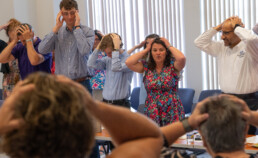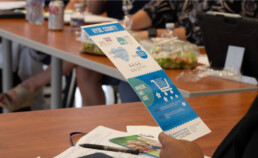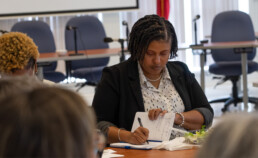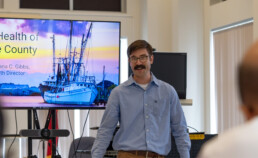Hyde County June 2023
Population
4,576
County Seat
Swan Quarter
Median Income
$48,577
Population Density Designation
Rural
Geographically and culturally, Hyde County is one of North Carolina’s most unusual and interesting communities. Nestled in the coastal plains, it’s a gateway to the Outer Banks (the ferry at Swan Quarter is one of two routes to Ocracoke Island). Hyde County is rich in natural resources, wildlife and serenity; it’s home to five nationally protected areas; and most of the county’s square mileage is under water.
When the Blue Cross NC Extra Miles Tour landed at the county’s government center in Swan Quarter, the team learned about how the county’s significant assets also present significant challenges when it comes to health care delivery and economic development.
After welcoming remarks from County Commissioner Jan Moore, EMS Director Chris Pereira provided an in-depth discussion of the challenges facing the county’s emergency services. In some cases, these challenges are quirky enough to be a source of humor: The black bears are so prolific in the area that EMS response vehicles run sirens no matter the time of day or night to get them off the road. More significantly, the county’s unusual terrain and rural makeup turn just about any emergency call into a time- and resource-intensive event. On the mainland, it can take a responder 30 minutes just to reach a call, and even the most basic situation requiring transportation off Ocracoke Island has a 6-hour turnaround time. That’s important in an area with limited medical staff. Hyde County is small and remote, but many North Carolinians and out-of-state tourists travel through and to the area every year. Pereira shared his nightmare scenario: What happens if a school bus or tourist van gets into a serious accident? His concerns underscored how the challenges of any one NC county can impact lives in every NC county in some way. The conversation turned to how a much-needed acute care stabilization center and other investments would help lessen these challenges.
Luana Gibbs, from Hyde County Health Department, focused more on the health care workforce and infrastructural challenges. Currently, there is only one physician for every 4,900 people in the county. There are two Federally Qualified Health Care centers in the area, which provide a range of services including primary and pediatric care; care for farm workers; mental health care and substance use programming; and other fundamentals. But the county is only able to provide dental care for adults, and these services are available only one day each month. It has no dental services for children beyond fluoride varnishing, no mental health services for children outside of what the schools can offer, no inpatient care for children or substance users and limited support for children and families in the foster care system.
Laurie Potter, director of Hyde County Department of Social Services, explained that these limitations are especially problematic at this time as the county is seeing a dramatic increase in child abuse cases. She explained how the insufficient infrastructure to handle children’s needs has meant that within the past year, two children spent more than 200 days in hospital emergency rooms simply because there was nowhere else for them to go. Such ad hoc measures drive up health care costs for everyone; by her calculations, reliance on emergency room services for these two children alone costs taxpayers more than a quarter of a million dollars.
Hyde County children and families in the foster care system face their own unique challenges. Of all the Hyde County children experiencing foster care, only one resides in their home county. Most children are placed in homes more than 100 miles outside the county. One child resides nearly 400 miles from home. Being placed so far from home disrupts the continuity of care. Hyde County social service workers must travel hundreds of miles to support the children they serve; Potter shared that her one social worker travels 2,306 miles a month to fulfill their mandated visits to the seven children scattered across the state – that’s nearly the distance to Los Angeles. More importantly, these circumstances stack the deck against families working toward reunification.
“We’re not giving the parents a chance to succeed when their kids are hundreds of miles away,” explained Potter.
The second half of the day’s conversation focused attention on current and potential collaborative initiatives to address the county’s challenges. We heard from faculty members representing East Carolina University and Beaufort Community College, as well as Hyde County Public Schools, who shared details on how all levels of the public education sector are promoting community well-being; building the workforce to support local industry; refreshing and updating the skills of local health care workers; and helping area residents find pathways to sustainable, dignified lives in the county that they love.
Near the end of the visit, a remarkable exchange exemplified the power of breaking down silos and initiating cross-sector conversations. The discussion captured the essence of what our Extra Miles Tour is all about.
Laurie Potter had shared a vision: She hopes that the county could acquire two properties and turn them into much-needed facilities to support children in foster care, expanded dental care services, a space where affordable and much-needed housing could be built for medical and social services staff and more.
Others chimed in, eager to help her transform that vision into reality. Dennis Barber (acting director of East Carolina University’s Miller School of Entrepreneurship) explained that RISE29 specializes in bringing ideas like Potter’s to fruition. Joe Rockenstein, CEO of the Ocracoke and Engelhard medical centers, volunteered his own grant writer to help.
Mr. Rockenstein closed the morning’s meeting by adding, “Today’s conversation has made it clear how important it is that we all work together … and going forward I pledge to do just that.”
All other trade names are the property of their respective owners. U39702, 7/23





